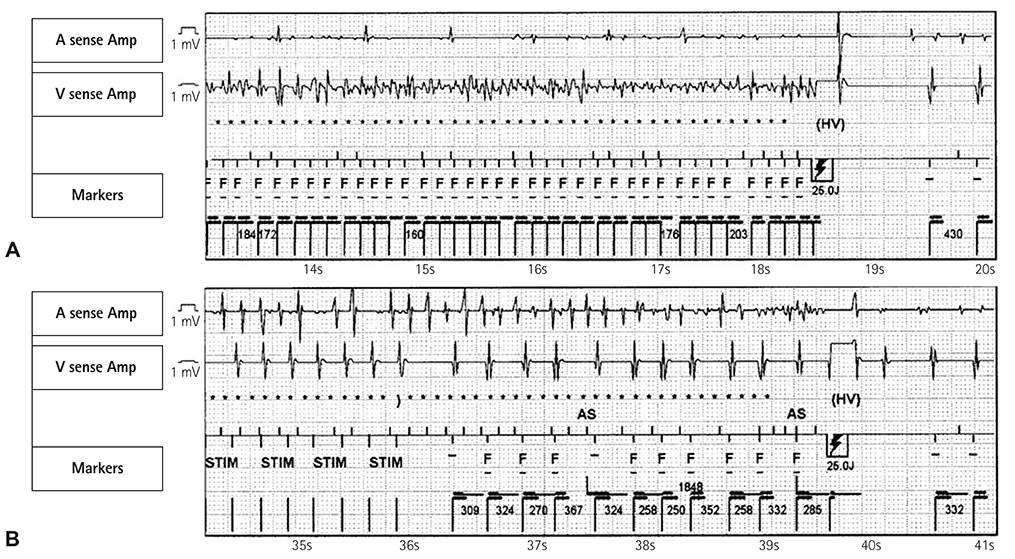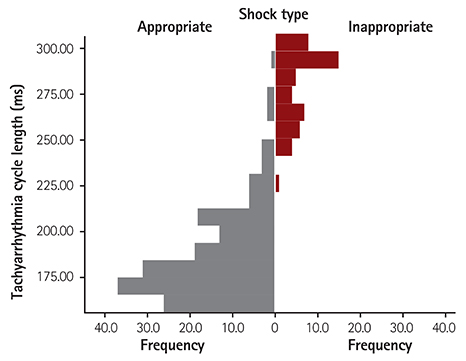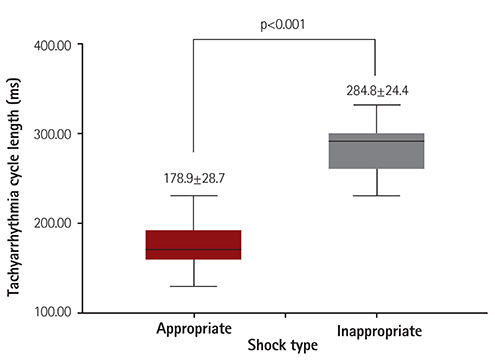Korean Circ J.
2016 Mar;46(2):179-185. 10.4070/kcj.2016.46.2.179.
Tachyarrhythmia Cycle Length in Appropriate versus Inappropriate Defibrillator Shocks in Brugada Syndrome, Early Repolarization Syndrome, or Idiopathic Ventricular Fibrillation
- Affiliations
-
- 1Division of Cardiology, Asan Medical Center, University of Ulsan College of Medicine, Seoul, Korea. mdjunkim@gmail.com
- KMID: 2344469
- DOI: http://doi.org/10.4070/kcj.2016.46.2.179
Abstract
- BACKGROUND AND OBJECTIVES
Implantable cardioverter-defibrillators (ICDs) are indicated in patients with Brugada syndrome (BS), early repolarization syndrome (ERS), or idiopathic ventricular fibrillation (IVF) who are at high risk for sudden cardiac death. The optimal ICD programming for reducing inappropriate shocks in these patients remains to be determined. We investigated the difference in the mean cycle length of tachyarrhythmias that activated either appropriate or inappropriate ICD shocks in these three patient groups to determine the optimal ventricular fibrillation (VF) zone for minimizing inappropriate ICD shocks.
SUBJECTS AND METHODS
We selected 41 patients (35 men) (mean age±standard deviation=42.6±13.0 year) who received ICD shocks between April 1996 and April 2014 to treat BS (n=24), ERS (n=9), or IVF (n=8). Clinical and ICD interrogation data were retrospectively collected and analyzed for all events with ICD shocks.
RESULTS
Of the 244 episodes, 180 (73.8%) shocks were appropriate and 64 (26.2%) were inappropriate. The mean cycle lengths of the tachyarrhythmias that activated appropriate and inappropriate shocks were 178.9±28.7 ms and 284.8±24.4 ms, respectively (p<0.001). The cutoff value with the highest sensitivity and specificity for discriminating between appropriate and inappropriate shocks was 235 ms (sensitivity, 98.4%; specificity, 95.6%). When we programmed a single VF zone of ≤270 ms, inappropriate ICD shocks were reduced by 70.5% and appropriate shocks were missed in 1.7% of these patients.
CONCLUSION
Programming of a single VF zone of ≤270 ms in patients with BS, ERS, or IVF could reduce inappropriate ICD shocks, with a low risk of missing appropriate shocks.
MeSH Terms
Figure
Reference
-
1. Brugada P, Brugada J. Right bundle branch block, persistent ST segment elevation and sudden cardiac death: a distinct clinical and electrocardiographic syndrome. A multicenter report. J Am Coll Cardiol. 1992; 20:1391–1396.2. Haïssaguerre M, Derval N, Sacher F, et al. Sudden cardiac arrest associated with early repolarization. N Engl J Med. 2008; 358:2016–2023.3. Nam GB, Kim YH, Antzelevitch C. Augmentation of J waves and electrical storms in patients with early repolarization. N Engl J Med. 2008; 358:2078–2079.4. Brugada J, Brugada R, Antzelevitch C, Towbin J, Nademanee K, Brugada P. Long-term follow-up of individuals with the electrocardiographic pattern of right bundle-branch block and ST-segment elevation in precordial leads V1 to V3. Circulation. 2002; 105:73–78.5. Haïssaguerre M, Sacher F, Nogami A, et al. Characteristics of recurrent ventricular fibrillation associated with inferolateral early repolarization role of drug therapy. J Am Coll Cardiol. 2009; 53:612–619.6. Bordachar P, Reuter S, Garrigue S, et al. Incidence, clinical implications and prognosis of atrial arrhythmias in Brugada syndrome. Eur Heart J. 2004; 25:879–884.7. Sarkozy A, Boussy T, Kourgiannides G, et al. Long-term follow-up of primary prophylactic implantable cardioverter-defibrillator therapy in Brugada syndrome. Eur Heart J. 2007; 28:334–344.8. Sacher F, Probst V, Maury P, et al. Outcome after implantation of a cardioverter-defibrillator in patients with Brugada syndrome: a multicenter study-part 2. Circulation. 2013; 128:1739–1747.9. Schron EB, Exner DV, Yao Q, et al. Quality of life in the antiarrhythmics versus implantable defibrillators trial: impact of therapy and influence of adverse symptoms and defibrillator shocks. Circulation. 2002; 105:589–594.10. Kamphuis HC, de Leeuw JR, Derksen R, Hauer RN, Winnubst JA. Implantable cardioverter defibrillator recipients: quality of life in recipients with and without ICD shock delivery: a prospective study. Europace. 2003; 5:381–389.11. Xie J, Weil MH, Sun S, et al. High-energy defibrillation increases the severity of postresuscitation myocardial dysfunction. Circulation. 1997; 96:683–688.12. de Vries JW, Bakker PF, Visser GH, Diephuis JC, van Huffelen AC. Changes in cerebral oxygen uptake and cerebral electrical activity during defibrillation threshold testing. Anesth Analg. 1998; 87:16–20.13. Gasparini M, Proclemer A, Klersy C, et al. Effect of long-detection interval vs standard-detection interval for implantable cardioverter-defibrillators on antitachycardia pacing and shock delivery: the ADVANCE III randomized clinical trial. JAMA. 2013; 309:1903–1911.14. Moss AJ, Schuger C, Beck CA, et al. Reduction in inappropriate therapy and mortality through ICD programming. N Engl J Med. 2012; 367:2275–2283.15. Priori SG, Wilde AA, Horie M, et al. HRS/EHRA/APHRS expert consensus statement on the diagnosis and management of patients with inherited primary arrhythmia syndromes: document endorsed by HRS, EHRA, and APHRS in May 2013 and by ACCF, AHA, PACES, and AEPC in June 2013. Heart Rhythm. 2013; 10:1932–1963.16. Klein RC, Raitt MH, Wilkoff BL, et al. Analysis of implantable cardioverter defibrillator therapy in the Antiarrhythmics Versus Implantable Defibrillators (AVID) Trial. J Cardiovasc Electrophysiol. 2003; 14:940–948.17. Raitt MH, Dolack GL, Kudenchuk PJ, Poole JE, Bardy GH. Ventricular arrhythmias detected after transvenous defibrillator implantation in patients with a clinical history of only ventricular fibrillation. Implications for use of implantable defibrillator. Circulation. 1995; 91:1996–2001.18. Cook SC, Valente AM, Maul TM, et al. Shock-related anxiety and sexual function in adults with congenital heart disease and implantable cardioverter-defibrillators. Heart Rhythm. 2013; 10:805–810.19. Dubin AM, Batsford WP, Lewis RJ, Rosenfeld LE. Quality-of-life in patients receiving implantable cardioverter defibrillators at or before age 40. Pacing Clin Electrophysiol. 1996; 19(11 Pt 1):1555–1559.20. Wathen MS, DeGroot PJ, Sweeney MO, et al. Prospective randomized multicenter trial of empirical antitachycardia pacing versus shocks for spontaneous rapid ventricular tachycardia in patients with implantable cardioverter-defibrillators: Pacing Fast Ventricular Tachycardia Reduces Shock Therapies (PainFREE Rx II) trial results. Circulation. 2004; 110:2591–2596.21. Veltmann C, Kuschyk J, Schimpf R, et al. Prevention of inappropriate ICD shocks in patients with Brugada syndrome. Clin Res Cardiol. 2010; 99:37–44.22. Yokoshiki H, Kohya T, Sato M, et al. Increased cycle length variability during ventricular fibrillation: a novel predictor of arrhythmia recurrence. J Electrocardiol. 2003; 36:137–146.23. Lever NA, Newall EG, Larsen PD. Differences in the characteristics of induced and spontaneous episodes of ventricular fibrillation. Europace. 2007; 9:1054–1058.24. Li H, Easley A, Windle J, Samoil D, Barrington W. The mean ventricular fibrillation cycle length: a potentially useful parameter for programming implantable cardioverter defibrillators. Pacing Clin Electrophysiol. 1998; 21:1789–1794.25. Watanabe H, Chinushi M, Sugiura H, et al. Unsuccessful internal defibrillation in Brugada syndrome: focus on refractoriness and ventricular fibrillation cycle length. J Cardiovasc Electrophysiol. 2005; 16:262–266.26. Turitto G, Akhrass P, Leonardi M, Saponieri C, Sette A, El-Sherif N. Atrial flutter with spontaneous 1:1 atrioventricular conduction in adults: an uncommon but frequently missed cause for syncope/presyncope. Pacing Clin Electrophysiol. 2009; 32:82–90.27. Kawabata M, Hirao K, Higuchi K, et al. Clinical and electrophysiological characteristics of patients having atrial flutter with 1:1 atrioventricular conduction. Europace. 2008; 10:284–288.28. Delaney JT, Muhammad R, Blair MA, et al. A KCNJ8 mutation associated with early repolarization and atrial fibrillation. Europace. 2012; 14:1428–1432.
- Full Text Links
- Actions
-
Cited
- CITED
-
- Close
- Share
- Similar articles
-
- Early Repolarization Syndrome with Idiopathic Ventricular Fibrillation
- Clinical characteristics of patients with an implantable cardioverter-defibrillator: Our experience at Asan Medical Center
- Brugada Syndrome
- COVID-19 Vaccination-Induced Ventricular Fibrillation in an Afebrile Patient With Brugada Syndrome
- A Concealed Brugada Electrocardiogram Pattern Revealed after Administering Propafenone to a Patient with Atrial Fibrillation





